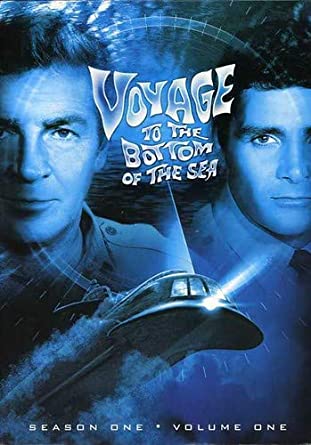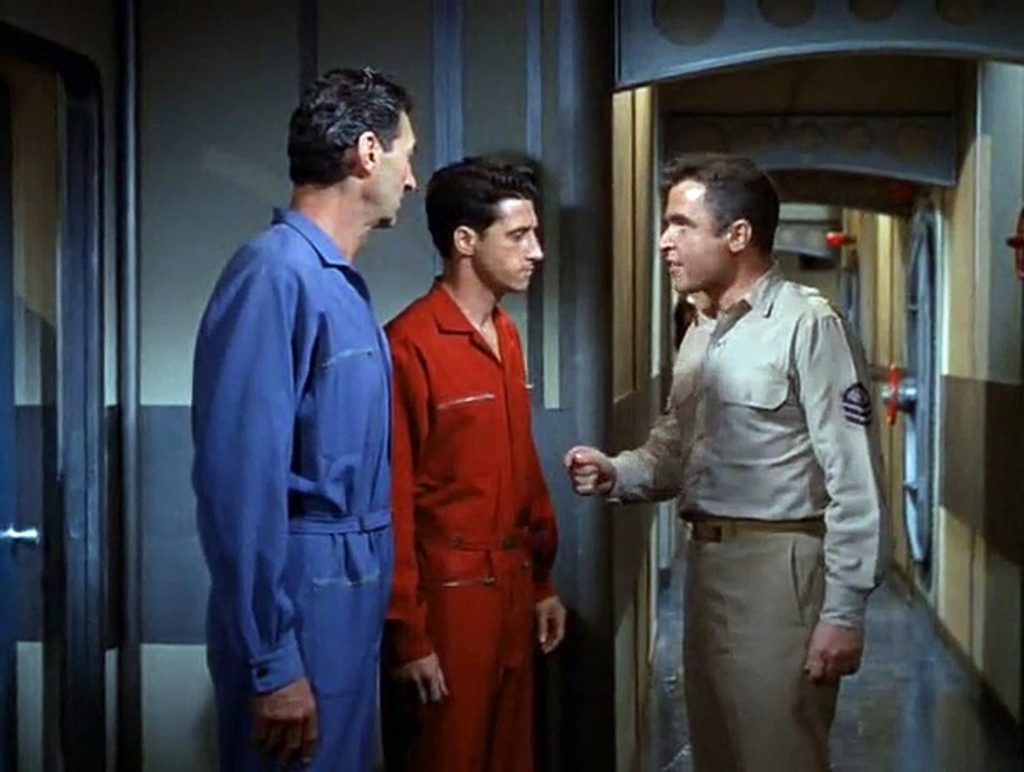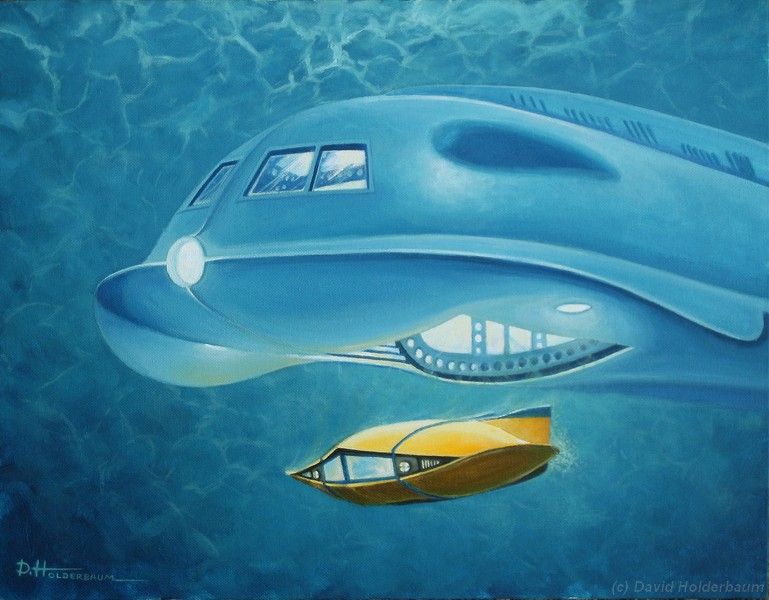Okay, here’s a trivia question for you on this Francis Friday. What was the longest running (in terms of episodes produced) non-anthology science fiction TV Series on the original ‘Big Three’ networks?
Well, if you read the title of this posting, you know the answer. Irwin Allen‘s Voyage to the Bottom of the Sea, which ran from 1964 through 1968 with 110 episodes.

The runner up to the title would be The Six Million Dollar Man on ABC which had 99 episodes. (The series also had 6 TV movies, but they all came later and were seperate things entirely.) Honorable mentions would be Quantum Leap on NBC with 97 episodes, and if you want to count ALF on NBC – which I say you can’t as that was really a comedy with just a quasi-sci fi premise – it had 102.
Take away the ‘non-anthology’ restriction and the original run of Twilight Zone is at the top with 156 episodes. Take away the ‘Big 3 Network’ restriction and The X-Files hits the top mark with 202 episodes for American-made TV. Include non-American TV and the prize goes to the classic Doctor Who obviously, which had 862 episodes.
(Much as I might be tempted to count the awesome original Dark Shadows soap opera on ABC with 1,225 episodes, which did employ some science fiction premises like Parallel Time for example, I think that muddies the water too much.)
Believe it or not, Voyage was actually the very first successful American science fiction TV series with recurring characters. Irwin Allen deserves the credit for making it all happen, and the series was based on a successful motion picture Allen had produced with Walter Pidgeon a few years earlier in 1961.
Using the models and loads of footage from the movie, Allen was able to sell the idea to ABC on the strength of the ‘adventure premise’ that the pilot ‘Eleven Days to Zero‘ laid out in 1963. The series went into production soon after that, and it’s first season aired on that final ‘black and white’ television season of 1964 to 1965. (The new fall season of 1965 saw the networks producing all color prime-time programming for their new shows for the first time, as the tipping point for the majority of American households having color sets had finally been reached.)
It has been said the the first season of Voyage was more of a ‘Cold War’ drama than anything else, but this is a bit of an inaccuracy. Yes, there were several such episodes, and many were excellent, such as ‘Doomsday‘ which dealt with the possibility of accidental nuclear war and the moral issues associated with such (well before the Vietnam War was underway mind you.) But there were actually a ton of well-written science fiction episodes that season too, such as ‘The Sky Is Falling‘ where the Seaview encounters a crash-landed alien spaceship, and ‘The Invaders‘, with the always-awesome Robert Duvall playing an awakened superior alien with designs on wiping out the human race.

With the second season came the advent of color, so new brightly colored coveralls became the standard uniform for the Seaview’s crew, playing towards the new color TV sets that were now in most American homes. (Did you ever wonder why the original Star Trek had such brightly colored uniforms? Same reason.)
With the addition of the ‘Flying Sub’, the series soon morphed into showing all science fiction nearly all the time, with most of the political intrigue stories gradually falling away. ‘The Sky’s on Fire‘ was an excellent second season episode that reused the premise of an ignited Van Allen Belt that was featured in the movie. The awesome character actor Alfred Ryder (who played Professor Crater in Star Trek’s first broadcasted episode ‘The Man Trap‘) played the malevolent ghost of a World War I German U-Boat captain named Kruger in two memorable episodes that season, ‘The Phantom Strikes‘ and ‘The Return of the Phantom‘.
The third and fourth seasons get a lot of grief for becoming essentially a ‘monster of the week’ show, and there is much truth to this. Budget constraints forced a lot of cheesy-looking costuming and weird premises, but many of these stories were still excellent. ‘Day of Evil‘ from the third season is one of the best of the entire series, where a shape-shifting alien takes the form of Admiral Nelson in an attempt to start a nuclear war as a prelude to colonization. ‘The Death Clock‘ from the fourth season is all about a time-hopping Captain Crane trying to prevent his own murder and it is amazingly good.

Just like with the Classic Doctor Who series, if the viewer can suspend their focus from the awful costuming and effects and concentrate on the story and the characters, Voyage still works most of the the time. Yes, of course there are loads of stinker episodes, like ‘The Terrible Leprechaun‘ and ‘The Lobster Man‘, both from the fourth season, but on the whole, the series entertained most of the time.
The characters and actors certainly contributed to the appeal and success of the show, despite some awful writing from time to time, enabling it to run a full four seasons. Richard Basehart, David Hedison, Bob Dowdell, Del Monroe and Terry Becker all gave fantastic performances time after time even when the stories were weak, making the series always enjoyable, even if only to be with them.
My love for the series came as a small boy through its syndication in the very early 1970’s when our local NBC affiliate featured it for several years in their 11:00 AM Sunday morning slot. (Star Trek would eventually displace it there.) The imagination that the show put forth (as did it’s sister show, Irwin Allen’s Lost In Space which Robert loves, and which our local independent station began showing weekdays in the after school hours a short time later) inflamed in me a desire for speculative fiction like nothing else, except for Star Trek of course, which actually came a little later. Yes, some of this is Generation X nostalgia, but so much of our ability to dream and ask eternal questions comes from our influences, and for me Admiral Nelson and his intrepid crew was certainly a big one.
The show was released on DVD beginning in the early 20-teens and I did purchase the whole series, and have rewatched it several times since then in its entirety (much to the chagrin of Mrs. Francis, unfortunately.) Effects aside, many of the stories still hold up well these many years later, and I’m glad that my early influences were not something I found myself cringing at later in life.
If you get a chance to watch some of the series, please give it a go. Amazon Prime has them for $1.99 per episode, although many of them are on YouTube in their full uncut entirety. If you’re looking for a few recommendations beyond the one’s I’ve already mentioned, you can try ‘Mutiny‘, ‘The Saboteur‘ and ‘The Traitor‘ from the first season, ‘The Cyborg‘, ‘The Deadliest Game‘ and ‘The Death Ship‘ from the second, ‘The Haunted Submarine‘, ‘Brand of the Beast‘ (my very favorite) and ‘Destroy Seaview!‘ from the third, and ‘Time Lock‘, ‘Blow Up‘ and ‘Nightmare‘ from the fourth.
Unless you’re extremely shallow I suppose, I think you’ll be pleased at the depths that this series will take you to . . . most of the time anyway. (Yes, puns are always fun.)
And because I always have to show some form of video, how about the credits from the series? From the second season episode ‘Leviathan‘ to be precise:




